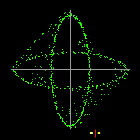
There are a huge number of digital modes available to the radio amateur nowadays. Some are relatively simple modes such as radio teleprinter (RTTY) which uses two tones (or a shift between two frequencies) to encode information. Others, such as MFSK and Piccolo, use multiple tones to encode information. Some digital modes have built-in error correction features such as AMTOR which uses FEC (or Forward Error Correction), or convolutional coding (Viterbi decoding), as used on some of the recent space probes.
Until recently, the two most commonly used digital modes were RTTY (radio teleprinter) and PSK (Phase shift keying). However, this has now been overtaken by the ‘JT’ modes such as FT8, FT4, JT65, JT9, etc.
RTTY is one of the oldest modes and originally used large (noisy) mechanical terminal units. Nowadays, virtually, all RTTY is software-based. Amateurs use 45 baud (speed) – sometimes 75 baud – and a shift of 170Hz between the mark and space tones. RTTY runs quite fast and is ideal for contesting.
PSK has been a very popular amateur digital mode (and can still be seen most days on the 40m and 20m bands). There are two types of PSK – BPSK and QPSK (Binary and Quadrature PSK) that run at various speeds. PSK31 is the most popular (although PSK 63 is growing in popularity – running at twice the speed it is quite good for contesting). PSK31 is a very narrow digital mode and has a bandwidth of only 31Hz which means that many PSK signals can fit into the bandwidth occupied by a single voice transmission (typically a SSB transmission has a bandwidth of 2.4kHz). PSK is an excellent chat-mode and runs at average ‘finger and thumb’ typing speed. Personally, I don’t think it is that great for contests as PSK 31 feels very slow compared to the average voice or RTTY contest exchange – but ultimately it is a personal preference.
WSJT-X is a software suite designed to facilitate basic amateur radio communication using very weak signals, as low as -24dB. ‘WS’ stands for Weak Signal and ‘JT’ stands for Joe Taylor K1JT, the Nobel prize-winning physicist (1993) and radio amateur who was instrumental in the design of the software. The suite comprises a number of different modes or protocols including FT8, FT4, JT4, JT9, JT65, MSK 144 and Echo. JT65 was initially designed for EME or ‘moonbounce’ communication. MSK144 is designed for communication using meteor scatter and aircraft scatter. The trade off in being able to communicate using very weak signals is that the information one can exchange is very limited (often just a callsign, locator and signal strength). A brief biography of Joe Taylor may be found here.
There are many software suites for digital modes (including slow scan television (SSTV). The most commonly used are MMTTY (for RTTY), MMVARI (for PSK), DigiPan (for PSK), Ham Radio Deluxe (for numerous digital modes), MMSSTV (for SSTV), fldigi (for many digital modes) and WSJT-X for the FT and JT modes. There are many others, but these are the most commonly used.
There are some very good primers on the internet so I do not intend to reinvent the wheel by repeating the same information here but point you to Sean, G4UCJ’s, excellent website which describes a huge range of digital modes, together with screen shots and audio samples.